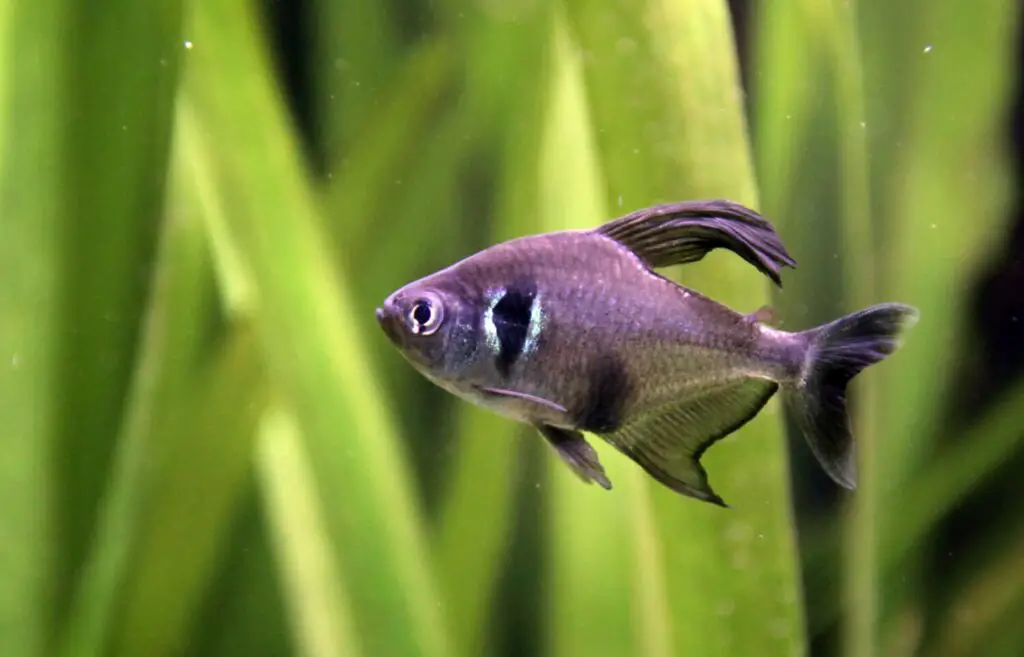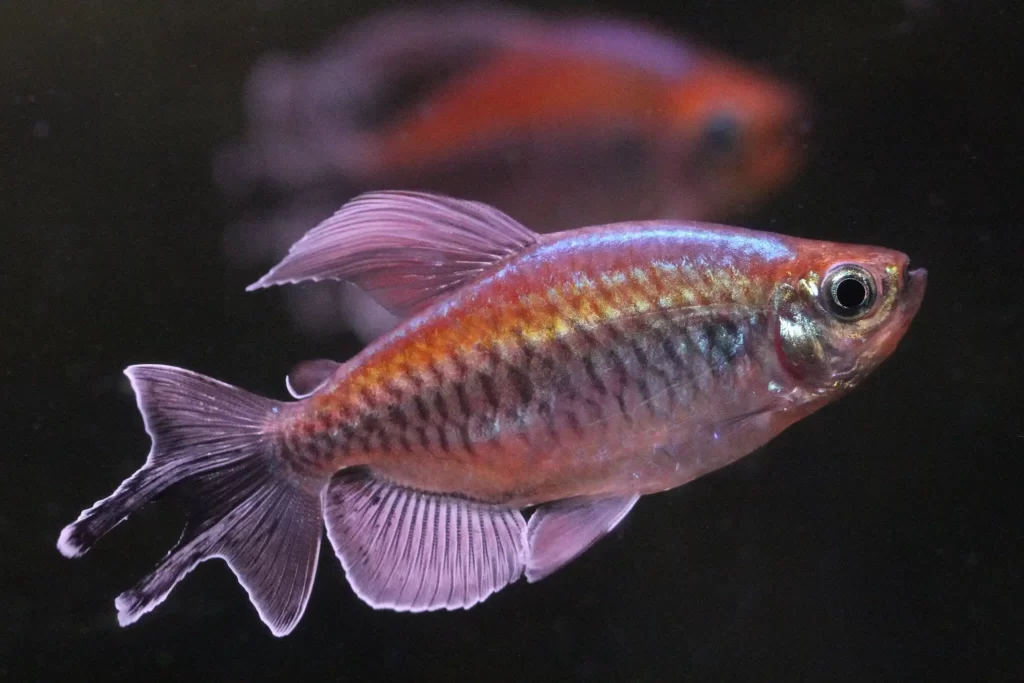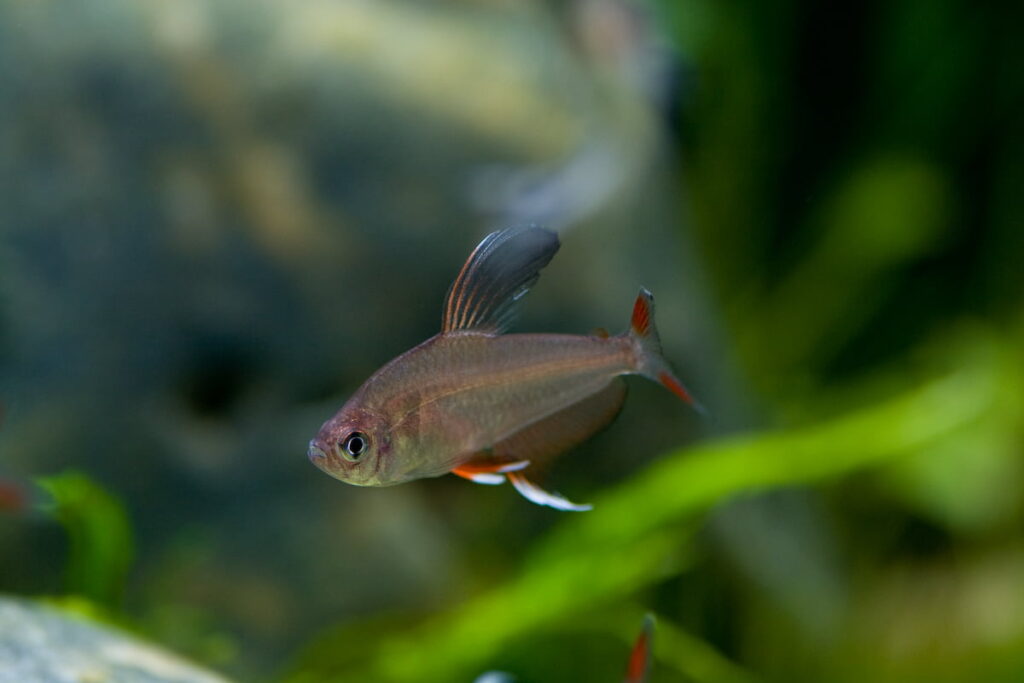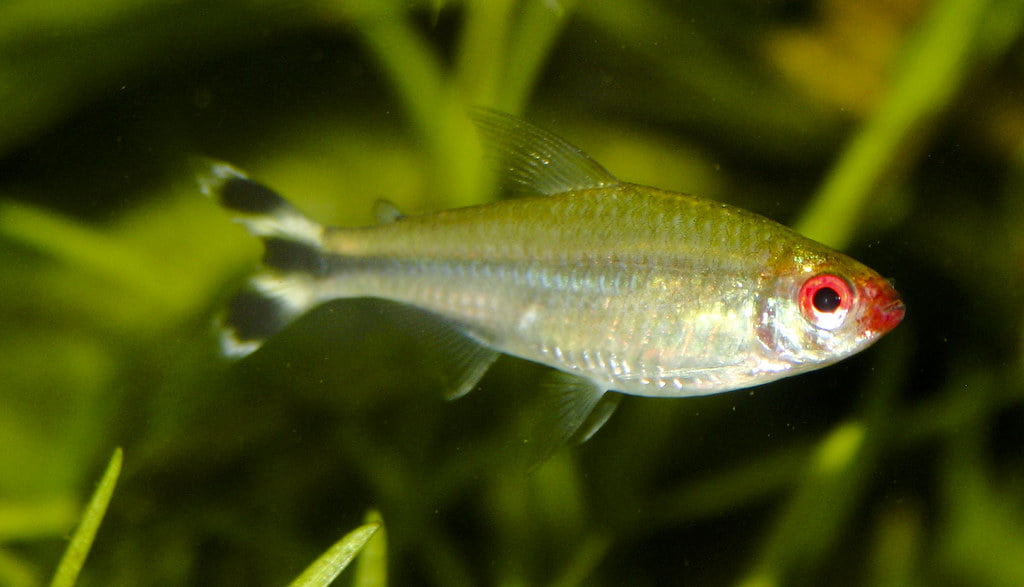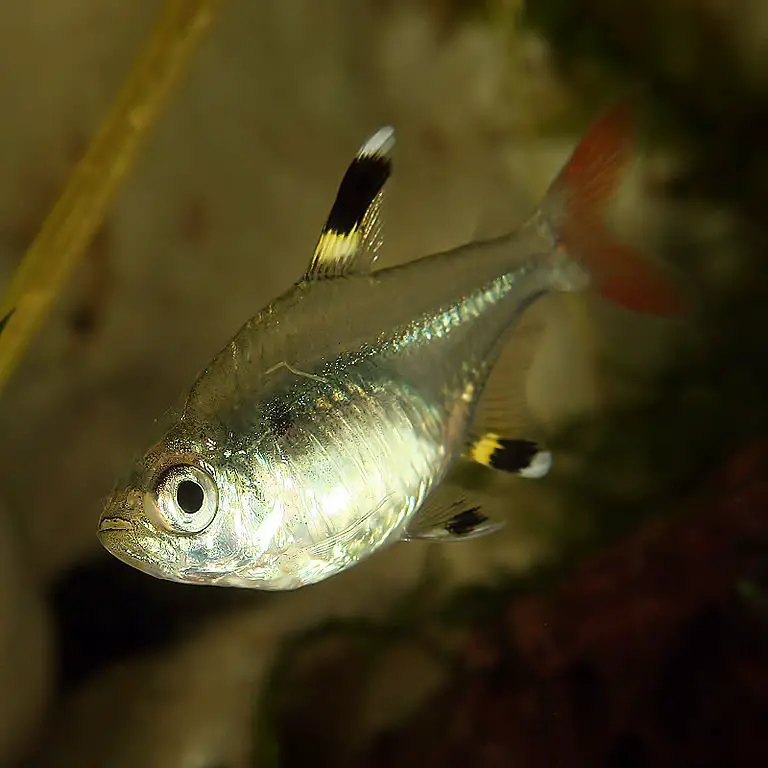One of the underrated and beautiful fish of the Tetra fish family is Black Phantom Tetra (Scientific Name: Hyphessobrycon megalopterus). These tetras are freshwater fish and beloved by many hobbyists. The unique feature of the black phantom tetra is the black patch on its body.
Black Phantom Tetras are very easy to care for and are very beautiful as well. The tetras are omnivorous and are easy to feed; they accept any form of food you give them.
As they are hardy fish, anyone with little experience in fishkeeping can easily care for them. However, you must require some knowledge about the fish and aquarium environment to keep them happy in your aquarium.
These fish are also the best active schooling fish. The colors can get more attractive when you can set up the right tank for them and provide them with a proper diet.
These tetras are similar to their cousins Red Phantom Tetra (Hyphessobrycon sweglesi). Their appearance is similar but has a reddish tingle to their body.
Let’s learn more about Black Phantom Tetra in detail so that you can easily house them in your aquarium happily.
Origin, Habitat in the Wild and Distribution (Hyphessobrycon megalopterus)
Black Phantom Tetra is freshwater fish of the Characidae family that was first described by Eigenmann in 1915.
These fish come from South America, upper Paraguay, and Brazil and are native to river basins such as the Guapore River and Rio San Francisco.
In Guapore and Paraguay, you can find these tetras in waters that flow into the wetlands of Pantanal. In other areas, you find them mostly in slow-moving and murky waters that are thick in vegetation.
These tetras are non-aggressive fish that prefer to live in groups. The fish is widely available and are inexpensive, making them highly recommended pets for household aquarium.
These fish are widely bred in captivity and distributed throughout the globe. Since catching them in the wild can hamper the ecosystem, most breeders capture only a few of them and breed them in captivity. The exported breeds are mostly captive-bred.
About Black Phantom Tetra (Hyphessobrycon megalopterus)
Black Phantom tetras are the most attractive and one of the easiest fish to keep. These fish are very hardy and are adaptive to various water parameters.
Due to this nature, these fish are great for the beginning aquarists who have a little knowledge about fish keeping.
The fish gets its name from its black translucent appearance. They also possess a beautiful black diamond patch with green or silver outlines on their bodies.
Much like other tetras, these tetras also have an oval-shaped body with 1.8 inches in length.
Let’s learn more about the black phantom tetras distinctively.
Appearance
The black phantom tetra, like other tetras, has an oval-shaped body from the side and is laterally compressed.
The fish have large black patches across its body. The color is mixed with a distinctive splash of black and a mixture of white and silvery gray.
You can easily differentiate these tetras from others by considering the unique tiny adipose fin, which is located in between their dorsal fins and caudal fins.
They have the name black phantom tetra because of having four unpaired fins, anal fin, caudal fin, adipose, and the dorsal fin.
Black phantom tetras are similar to other tetras and can only grow to the maximum size of 1.8 inches in length.
Availability
The black phantom tetras are widely distributed worldwide. As Black Phantom Tetras are bred in captivity rather than collecting them in the wild, the IUCN Red List marked the fish as Least Concern (LC).
The tetra does not have major widespread threats and is available in South America and central Brazil. These are particularly inexpensive than other fish and are readily available in pet stores across the USA and UK.
Price
The price of these tetras can vary according to the local pet stores. However, they are very affordable. The cost of the fish can range from $1.39 to $2.49 per fish.
These fish are mostly suitable for beginners who do not want to spend a lot of money. In total, you will be spending around $8 to $10 as these fish need to be purchased in groups of at least 6.
Lifespan
Generally, these tetras can live up to 8 years in the wild. However, with the proper care and diet, in-home aquarium, the fish can live 5 to 6 years.
You need to monitor their habitat for their well-being and stress-free conditions.
Sexual Difference
If you are planning to keep black phantom tetra, you will be able to distinguish between male and female black phantom very easily.
The most notable feature that differs females from the male is the color of these fish. The males are more grayish and have dark patches behind their gills. On the other hand, females have brighter coloration than males.
Female black phantom has a natural reddish hue to their pelvic fin, caudal, and anal fins. The males do not have these features. The female’s dorsal fin is also blacker than those of the males.
If you look closely, you can visualize that the females have fins that are shorter and smaller in comparison with the males.
Apart from that, you can also differentiate their sex by looking at their body as the male’s body shape is almost tetragonal.
Fish Keeping Difficulty
One of the distinguished factors of black phantom tetras is their flexibility. As the fish are hardy, they can adapt to a wide range of water parameters. This makes the fish an ideal and highly demanding fish for beginner aquarists as well.
Even though these tetras do not have a problem with the different water parameters, you cannot be ignorant of them. You need to ensure that your tank is clean and your fish do not latch on to various diseases.
The aquarium tank is a closed ecosystem, and the water does not travel to any other area. Hence, you are supposed to clean fish excretes, remove fish debris, etc. that can be present in the water.
If you are capable of performing these tasks regularly, the fish can live their entire life happily in your aquarium.
Social Behavior and Tank Mates
Black phantom tetras, like any other tetras, are a community fish and love to be in a school. Therefore, you need to keep a pack of at least 6 of their kind in your aquarium.
These tetras are very friendly with other species as well. If you are willing to pair these fish with other species, then you have to make sure that they are active as black phantom tetras.
These tetras get easily spooked, so you need to make sure that you provide them with the appropriate habitat with plenty of vegetation.
You may also see two male black phantom tetras fighting. This behavior is known as “mock” fighting, and they do not hurt each other, so you do not need to worry.
Make sure that you keep them with species that are similar in size to this tetra, as larger species can pose a threat to them.
When you keep them will slow swimmers, they can become very competitive with them regarding foods. This can make slow swimmer species starve.
Some of the best companions for the black phantom tetras are livebearers, danionins, Rasboras, other tetras, most gourami, peaceful bottom dwellers, and small cichlids.
Caring for Black Phantom Tetra
Even though the black phantom tetras are very hardy and can adapt to various water parameters, it is essential for you to provide them with all the care they need.
It is not very difficult to manage and care for the black phantom tetra. With a decent size tank, good aquarium water, the right temperature, right tank mates, and a proper diet, it will be very easy for you to look after the tank.
It is necessary to care for the fish as you care for human beings. As they live in a closed environment, maintaining the tank should be the utmost priority. The fish can be very stressed if the tank environment is not optimal.
Next will be discussing different factors influencing the care for black phantom tetra. Keep reading for more information.
Tank Size
Black phantom tetras, as I have mentioned earlier, are active schooling fish. These fish want to live in an environment that is large so that they can swim freely.
The most common mistake a beginner aquarist does is when choosing an aquarium. They try to buy a small size aquarium thinking this will require lesser maintenance.
However, it’s opposite to what they think. You should know that smaller aquariums are very hard to maintain. Therefore, tank size is the most important factor to consider. The bigger, the better.
The ideal minimum size for your aquarium should be at least 24 inches long, with at least 20 gallons in volume.
And this math is only for 6 of the black phantom tetras. Get a bigger tank if you want to add more fish.
Keep in mind that you should not overcrowd your tank, and you should only keep one black phantom tetra fish per gallon in the tank.
The bigger the tank size, the more it will be easy to manage the fish and their environment. This will provide you with the assurance that your fishes are happy and healthy.
Lightings
Black phantom tetras are more likely to live in the regions where there are heavy plantations in the wild. These areas of water do not have bright lightings. Thus, you should be using dim and subdued lightings in your aquarium.
The shaded lights bring out the best coloration in the fish and provide great beauty to the tank.
However, if you are planning to go for a planted aquarium, make sure you add enough hiding places and shades for the fish.
NICREW ClassicLED Aquarium Light is an ideal light for the aquarium with these tetras. they give low output and maintain the dim lit environment.
Decorations and Substrate
An important thing to consider while adding any decorations and substrate in your tank is to disinfect them from any toxins. This will prevent contamination/toxins from harming your fish.
The black phantom tetra does well in a densely planted tank. These tetras love to swim freely in the middle of the tank.
Hence, you should plant the tank with live or artificial plants around the sides and back of the tank. To mimic the fish’s natural habitat, you can use a biotope tank.
These tetras prefer dark gravel as well. You can use river sand with some driftwood and twisted roots for the decoration.
Seachem Flourite Black Clay Gravel can give your aquarium natural look and porous substrate for plants to grow in.
You can also add dried leave to the sand. The dried leaves will stain the water, causing it to become light brown, which will provide the tank with a natural look.
Diet for Black Phantom Tetra
As the black phantom tetras are omnivorous, they tend to eat whatever you serve them. It is very easy to feed these fish as well.
In the wild, the fish mainly gets to eat worms, small insects, and crustaceans. As these fish are small, they mostly feed on only tiny organisms.
If you are planning to keep a black phantom in your aquarium, you should try to feed them what they eat in the wild.
Generally, you can feed them with live, fresh, and flake foods. You need to give them high-quality flake food every day to keep the balance in their diet.
You can treat them with brine shrimp, either live or frozen or bloodworms, once in a while as well. Feed them twice a day and make sure you do not overfeed them as well.
These fish have smallmouth; hence, you need to provide them with crushed foods and not large foods. You only need to provide meals that the fish can consume within 3 to 5 minutes.
If the fish do not eat the food, you need to remove it as quickly as possible otherwise, it can disrupt the balance of the ecosystem in your tank.
Maintain Water Quality for Black Phantom Tetra
Although Black Phantom Tetras are hardy fish, they are still sensitive to water parameters. Their colors might fade away as the temperature drop and pollutants increases in your tank.
And this also causes fish to be vulnerable to many diseases. Nevertheless, it is better to provide them with the care they require.
You can install a good filtration system to make things easier for you. You cannot see the pollutant in the water, can you? No right?
So, always use aquarium test kits to test ammonia, nitrite, nitrate, phosphates, pH, and hardness of your aquarium water.
Here are some of the factors you need to take care of before adding the fish to your tank or in your routine check-up.
Read further for more information.
Water Temperature
Fish are cold-blooded species, which means that they cannot regulate their body temperature.
Hence, when the water temperature change, their body temperature also changes. If the water temperature alters drastically, it might hamper the fish’s health.
The perfect water temperature for black phantom tetras can be from 72°F to 82°F. (22 to 28°C). You need to maintain this temperature at any cost as this has a direct effect on the fish’s metabolism.
If the water in your aquarium is too cold, then there will be a slow pace in your fish’s metabolism, and warm water can increase their metabolism.
The drastic and rapid fluctuations in the water temperature can weaken the immune system of the fish and make them prone to various diseases.
To stop this, you can use a good quality automatic aquarium heater and monitor the temperature regularly using a thermometer.
Hitop Submersible Adjustable Aquarium Heater is an ideal choice for an aquarium heater in the tetra tank.
pH and Hardness
If you have been researching about keeping fish, then you must be aware of various toolkits that can determine the pH level and hardness of the water in the tank. Maintaining pH level means maintaining the acidity of the water.
The preferred pH level for black phantom tetras ranges from 6.0 to 7.5. The hardness of the water should be ten dGH.
Hard water has many dissolved minerals in the water. The hardness of the water directly affects the pH level as the mineral in hard water acts as a buffer that will reduce the acid in water.
So, to maintain a balanced pH and hardness of water, do change 10% aquarium water every other day or 50 percent water each week.
Filtration
Filtration is the core of your aquarium. Installing filters can be very beneficial to the aquarium as it traps solid wastes from the water and converts liquid wastes into a relatively harmless form (ammonia into nitrite and nitrite into nitrate). This process is called the aquarium nitrogen cycle.
You need to consider and boost the cycle of your aquarium called the nitrogen cycle. To boost, you need to use aquarium filters that can store more bio media to develop better bacteria when the tank ages.
The good bacteria feed on harmful chemicals like ammonia and nitrite and produce nitrate, which is less harmful to the fish.
There are filters like mechanical filters and biological filters. The mechanical filters help to remove debris from the water that makes your aquarium clean.
Biological filtration breaks down dangerous wastes such as ammonia, converting them to nitrites, and then breaks the nitrites into nitrates that are non-toxic or lesser toxic than others.
The cycle in the tank, with the help of a high-quality filter, can circulate oxygenated water throughout the tank.
A canister filter is a filter you should go for as it has a large volume that can store a large amount of filter media.
Penn Plax Cascade 400 Submersible Aquarium Filter is a highly recommended canister filter you can use in your black phantom tetra tank.
Water Maintenance
Installing the filtration system and using test kits can help you maintain the consistency of water and pollutants from the tank.
However, it does not remove all the chemicals. So, no matter what filter you use, if you do not change the water regularly, it will not help the tank.
You need to know that the aquarium is not a natural ecosystem, and it is a closed system. Therefore, all the bacteria remain in your tank unless you remove them.
You do not need to and shouldn’t add other chemicals to the tank because you need to keep the tank as organic as possible. Just do water changes weekly, and you are good to go.
You just need to spend some extra effort and time maintaining the tank. You can use test kits like API master test kit that are widely available in the pet store or on Amazon to test your tank’s water parameter.
Some of the activities that you need to consider are pH level, hardness, and regulations of ammonia, nitrite, and nitrate level.
Besides, you need to replace the tank water by 10% every week. Make sure that you use fresh water at the proper temperature, which is similar to the tank water.
Fish Diseases
Living in a closed environment, the fish are not immune to various diseases. Black phantom tetra, like most fish, is prone to diseases such as ichthyobodo infection, skin flukes, parasitic infestations, bacterial infections, and other common fish diseases.
As the tetras are extremely hardy and mainly diseases are not usually a problem in the well-maintained aquarium. If you add any kinds of decorative items to your tank, it can also bring in many diseases.
One of the easiest things about black phantom tetra is that due to their resilience, it will be easy to prevent disease outbreaks. You can limit the disease to only one fish when you can catch them early. You can research a few of the diseases, and then you will realize the telltale signs.
Breeding Black Phantom Tetra
The black phantom tetra is very easy to breed. To get the best care for the fish eggs and the fry, you need to set up a separate tank.
Breeding Tank Requirements Of Black Phantom Tetra
The tank should not be bigger than 10 gallons so that you can keep the tank range from 3 to 5 gallons. The breeding tank should also be dimly lit and densely planted.
The plantation should include spawning mops or java moss that can provide a place for the females to lay their eggs.
You also need to provide the ideal breeding tank for replicating the Condition of the water to their natural habitat.
The temperature should be about 77°F (25°C). The water needs to be relatively soft with a pH level, about 5.0 to 5.6, to stimulate breeding.
The water hardness should be below 4° dGH. You can filter the water through a small sponge filter, which is air-powered, or through peat, which is aquarium safe.
Breeding And Spawning Of Black Phantom Tetra
The female will scatter between 300 to 400 eggs in one spawning, and the male will fertilize them.
The tetras are best spawned in pairs, as males get aggressive with one another when breeding or defending a territory. So, 2:1 is the best ratio for female and male black phantom tetra.
Once the fish spawning completes, you must remove the parents as they tend to eat the eggs and fry.
The eggs can hatch in a day, but they can be very susceptible to fungus. You need to expose the fry to very little light so that the fungus does not spread in other eggs. The fry may swim after about five days.
For the first few days, you can feed them with Infusoria-type foods until they can feed on a micro worm or brine shrimp nauplii.
Even though the breeding of black phantom tetra is easy, you need to keep in mind that male tetras can become very aggressive towards one another. Hence, you need to take care of the tetras carefully.
Conclusion
These tetras are very delightful to watch. It requires minimal care and is widely available. You will not regret purchasing them, and your tank will be the center of attraction.
I have tried to provide almost all the information about black phantom tetra through this article. However, if you still need some more information, you can contact me via the comment section below. I will reply to your queries.
If you are interested in similar breeds of tetras, you can check out our other articles as well.
